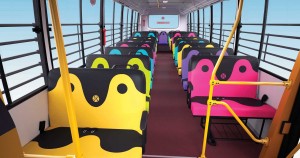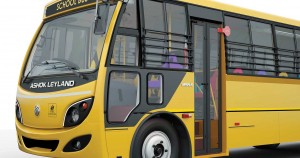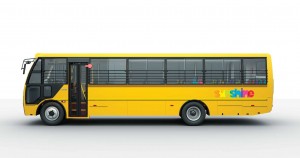Ashok Leyland’s new Sunshine school bus adds a new dimension to the world of school buses in India.
Story by: Bhargav TS
Photos: Ashok Leyland
With the rise in urbanisation, school buses have turned out to be the safest and the most convenient means of transport for students. From conversion of conventional buses and vans to ferry students, to school buses that comply with what are termed as one of the strictest bus regulations in the country ever, schools buses have changed a good deal over the last few years. They all come painted in a shade of yellow. It is not surprising therefore that Ashok Leyland found it appropriate to name their new school bus as Sunshine. Sunshine somehow reminds of the sunflower, which is bright yellow in colour, and stands out. Sunflower fields make an attractive sight with the flowers giving an impression of facing the sun always, much like school students as they ride the school bus; their minds immersed in the thought of studies. It is quite a sight to see a modern school bus roll by as it picks up students, stopping in front of every gate of a locality. The variety of school buses, all painted yellow, is a sight to behold. They come in different sizes and shapes. They may all look yellow, but their appearance and build differs, much like the students who ride them. Each student is a reflection of his or her parents who can be quite demanding of a school bus their child rides in. Exceptations about school buses are clearly rising.
On a new platform
School bus operators will agree, that school buses are not an easy business. That, it is no longer about ferrying a student to school over a few kilometers, but about how it is done. Rising demand for air-conditioned school buses is one aspect, the change desired of a school bus is another. Shining bright at Auto Expo 2016, the Sunshine was unvieled amid much fanfare. It highlighted many firsts for a school bus. An outcome of the hard work put in by Ashok Leyland team, which consisted of 80 R&D engineers. Built on a new platform, which particularly emphasises upon safety and comfort of the children, the Sunshine is expected to compete against existing school buses from Volvo Eicher Commercial Vehicles, SML Isuzu, Tata Motors, and from the home stable of Ashok Leyland. According to Dr. N Saravanan, Senior Vice President – Product Development, Ashok Leyland Ltd., “The Sunshine (school bus) focuses on safety, and on small things such as the lower height first step for easy and safe ingress and egress of pupils.” “School bus accidents are mostly caused by a blind spot. In our school bus, we have ensured that the driver has superior visibility on the co-driver side,” he adds.Ashok Leyland has put a collison warning system, and has leveraged technology to come up with small but important features like anti-bacterial seat fabric. “Understanding the customer perspective is important,” mentions Dr. Saravanan.
With a firm desire to develop a product that will be better than the ones that exist, a decision to design and develop a school bus from scratch was taken. The team in charge of the project travelled the length and breath of the country to get customer feedback. After two months of extensive research the design engineers went to the drawing board to create a design. Such were the efforts taken, that children of its employees were invited. They were called upon to speak about their requirements. These were considered. The feedback received was collected and a decision to incoprorate them was taken at the time of drafting the final design. The Sunshine school bus is thus a completely customer driven product. It was developed to ensure a leading position for Ashok Leyland in the school bus segment.
Roll-over compliant
Roll-over compliance is not necessary as per the new school bus code AIS063. Ashok Leyland decided to factor in roll-over compliance when developing the Sunshine however. The school bus is thus arguably the first of its kind in India to boast of roll-over compliance, and offers frontal crash protection as well. For Sunshine, Ashok Leyland employed special steel (YST350), which has a high yield strength. By using high yield strength material, the engineers were able to achieve rollover compliance. It is an innovative way of achieveing roll over compliance, mentioned a Ashok Leyland source, without increasing the weight considerably. The use of high strength steel has in fact seen the weight of the bus structure go down by 200 kg. The cost of raw material has escalated by 15 per cent.
Safety and convience take precedence
On Ashok Leyland’s VVC test track on the outskirts of Chennai, the Sunshine stood, basking under the afternoon rays of the sun. A high security area with restricted entry since new product development, testing and validation is carried out here, it was afternoon by the time we could get to the bus. A sunny day it was, and the Sunshine, like a pretty sunflower, stood there with its smilling face. Inviting us to it; an effect that is certain to extend to many pupils who will ride the bus to school everyday. A school bus with a pleasant demeanour, the Sunshine lacks a grille at the front. The curvature of the gap between the front panel and the bumper is such that it signals a smile. The design works, and the Sunshine attracts. The lamps are placed at either end of the curve in an enclosure. After making a lot of front designs, the designers took them to numerous school childrens. They seemed to prefer the smiling face design. It was selected. The windshield of the Sunshine is big and wide. It drops down low to offer a good visibility of the near-front. A good view of the vicinity with nary a blind spots is necessary for a school bus. It is afterall armed with the task of ferrying pupils that are intelligent and studious. The OVRMs may look a size smaller, they have been designed to rule out any possibility of a blind spot.
Walk over, and the expanse of the Sunshine comes into view. Capable of seating 40 pupils in a 2×2 seating layout, and 50 pupils in a 3×2 seating layout, the Sunshine measures 9415 mm in length.
The sides are neatly laid out. The large windows in the driver compartment have been carefully designed to ensure that the driver has a good view of the near-side. They are designed such that the driver can keep a watchful eye on the pupils that are boarding the bus, and alighting it. Riding on 7.50×16 6PR tyres, the Sunshine is fitted with drum brakes. They are ABS asisted. Attention was given to have even load distribution. This ensures a longer life of tyres, and results in superior traction.
To ensure safety of the children, the door for the passenger compartment (service entry) was placed behind the front axle. The low first step facilitates easy entry and exit. If a child does try to alight before the bus has come to a complete halt, the distance between the door and the rear axle is such that the driver will have the time to brake hard and halt the vehicle. Another consideration for not keeping the passenger (service entry) door ahead of the front axle was to ensure safety. If the front caves in during a front-end collision, the occupants can still exit rather than be held back by a broken windshield and a door that is no longer functional.
Ashok Leyland engineers have positioned the air filter behind the front wheel arches to improve NVH. In most buses, it is found to be placed in the driver compartment. As per the new code, the emergency exit on the Sunshine is on the right and closer to the rear. Adequate space between the seats allows for easy exit through the emergency door. Interestingly, as per the different Regional Transport Office (RTO), the Sunshine is engineered to have emergency exits in different locations. In case of the Maharashtra bound Sunshine, the emergency exit is placed at the rear. Designed to take into account the differing requirements of the customers, pupils as well as the regulations, which are known to differ from region to region, and from state to state, the Sunshine is a smart school bus. The rear has tail lamps placed in black surrounds, much like the front lamps are.
The i-ALERT feature the Sunshine incorporates is a state-of-the-art tracking software. Through this software, parents can monitor their child’s movement and location on a real-time basis. The software, embedded into the bus, is desigend to provide the parents with pick-up and drop-off alerts. School authorities, in addition, can use the system to monitor the well-being of their pupils inside the bus. The health of the vehicle can be tracked too.
Room for comfort
The ample glass makes for a roomy and comfortable interior of the school bus. If the low step height entry facilitates easy ingress and egress, the Sunshine boasts of being the first school bus to offer a lower floor height. The interior makes use of bright colours. Something that the children are going to like a lot. The designers have laid emphasis on colourful decals; the seats have colourful anti-bacterial fabrics, which is claimed to be the first on a school bus. They do not let the bacteria grow on them, and affect the skin’s natural balance. Anti-bacterial coating has also been applied on frequently touched parts. These have been dermatologically tested. The seats are comfortable and well cushioned, and there’s good amount of understorage space for stacking the school bags. Equipped with a hat rack and bottle holders, the Sunshine is equipped with a fire retardant interior. Stress on ventilation is evident.
Besides ample glass area, which enables good amount of light to find its way into the compartment, the Sunshine offers separate window for each row. The windows are big, and truly unique is its semi-integral construction . It is this property that has enabled the engineers to design the lowest fixed entry a school bus can offer. The centre of gravity of the bus is also low. This is claimed to improve stability by a good margin. Suspension is made up of parabolic leaf springs. Particular attention has been given to NVH. Subjected to rigorous tests to ensure that vibrations are kept well within the limits and facilitates good comfort and a pleasant ride, the Sunshine is equipped with push-to-fit connectors that prevent air locks. An in-tank feed pump is used for automatic air-lock removal and the fuel tank comes with aluminised interiors to prevent rust and corrosion.
Behind the wheel
What first draws attention is the amount of visibility the ample glass area in the driver compartment offers from behind the wheel. The driver console looks neat and is well laid out. It is the shape of a half circle. The instrument cluster is at the centre, and surrounded by various switches. Attention to ergonomics ensures that various controls are within reach. The driving position, though not high, is commanding and the view ahead is uninterrupted. Good refinement is indicated by the fact that vibrations are well contained as the 100 hp, four-cylinder common-rail turbo-diesel engine (available in BS III and BS IV configuration) comes to life. Slot into the gear and start moving; the Sunshine feels energetic and smooth. The peak torque the engine produces is 320 Nm @ 1200 rpm. The hydraulically-assisted steering wheel, offers a good feel of the surface under the wheels. The cable actuated gear shift works well. The feel of it is better than the linkage-type shifts found on many buses. Engineered to lead a hard life of frequent starts and stops, the refined feel the Sunshine conveys does not diminish with speed. Well arranged ratios of the five-speed gearbox makes for good tractability. There is a good spread of power, and the 17.1 m turning radius aids manoeuvrability. To ensure easier manoeuvrability, the engineers have pushed the front axle ahead as much as they could. Engineered to find its way through the narrow roads of the city, the Sunshine measures 2200 mm in width and 2700 mm in height. Its wheelbase is 5200 mm.
With a GVW of 7900 kg, the Sunshine is reflective of the changing requirements of the school bus segment, and how manufacturers are proactively addressing them. An example of frugal engineering, the Sunshine school bus, it is clear, has been designed and developed by keeping the needs of the drivers, operators, school management, children and parents in mind. Highlighting the fact that school buses are no longer a mere means of going to school or returning home, the Sunshine indicates that they are becoming a hotbed of technology, safety, comfort and convenience. Adding a new dimension to the world of school buses, the Ashok Leyland Sunshine seeks the best balance in a highly competitive per seat market.






























